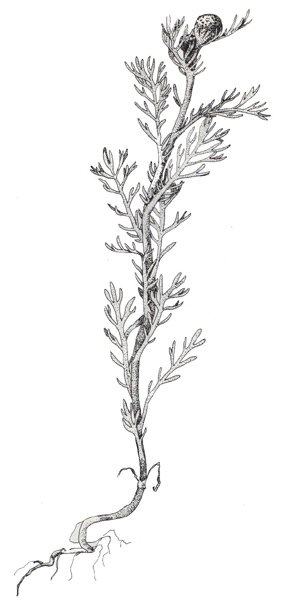

Chamomile
Matricaria matricarioides
(Compositae)
Description:
Chamomile's head, or capitulum, of small yellowish green
flowers forms a rounded cone. The bracts of scales around the base of the flowers
have thin, transparent (scarious) membranes along their edges. There are no
ray flowers or "petals" such as one finds in the aster, daisy, and another "chamomile,"
Anthemis. The leaves, finely dissected in featherlike lobes,
may be more or less pointed at the ends. The round and furrowed stem measures
3 inches to 1 foot (8 to 30 cm.) tall. This particular species of chamomile
is called pineapple weed because it smells like pineapple.
Distribution:
Matricaria matricarioides is a cosmopolitan
weed. (Hulten) It seems to share the property of the other chamomiles (Anthemis
nobilis and Matricaria chamomilla)of growing on seldom-used paths
and roads.
Constituents:
Three recent papers have been published on the substances
contained in German chamomile, M. chamomilla.Saleh found that red light
increases the production of flower heads, while green light has a better effect
on the quality of heads and percent of essential oil and chamazulene. Felklova
and Jasicova published an article on the substances contained in M.
chamomilla in 1975 in Czechoslovakia. And Padula, Rondina,
and Coussio determined essential oil, total azulenes, and chamazulene in M.
chamomillacultivated in Argentina.
Medicinal uses:
The Tanainas boil the whole above-ground portion of the
plant in water, strain the tea, and give it to a new mother and her baby to
drink. They say it cleans them out and helps the mother's milk start. The Kenai
Tanainas give the tea to anyone who needs a laxative and use it as a wash for
the eyes and skin. (Kari) The Aleuts and Russians used the tea as a cure-all.
(Smith)
I have found that tea made from the whole plant or the flowers with the leaves attached is very bitter indeed. A tea made from the flowers alone, however, tastes fragrantly sweet and quite similar to familiar chamomile tea.
Anthemis, the commercial chamomile, has been used to treat colds, fevers, painful and congested menstruation, bilious headache, indigestion, colic, spasms, coughs, bronchitis, pulmonary catarrh, acute dyspepsia, hysteria, nervousness, torpid liver, delirium tremens, rheumatism, ulcers, stomach weakness, ague, dropsy and jaundice. It has also been used when there are kidney, spleen, or bladder problems. It has been taken to expel worms, used as a wash for eyes and open sores, and in a poultice for swellings and toothaches.
Christopher describes Anthemisas diaphoretic, stomachic, tonic, antispasmodic, stimulant, sedative, emmenagogue, anthelmintic, anodyne, bitter aromatic, emetic (warm large dose), and cathartic (large dose).
Copyright © 1987 by Eleanor G. Viereck